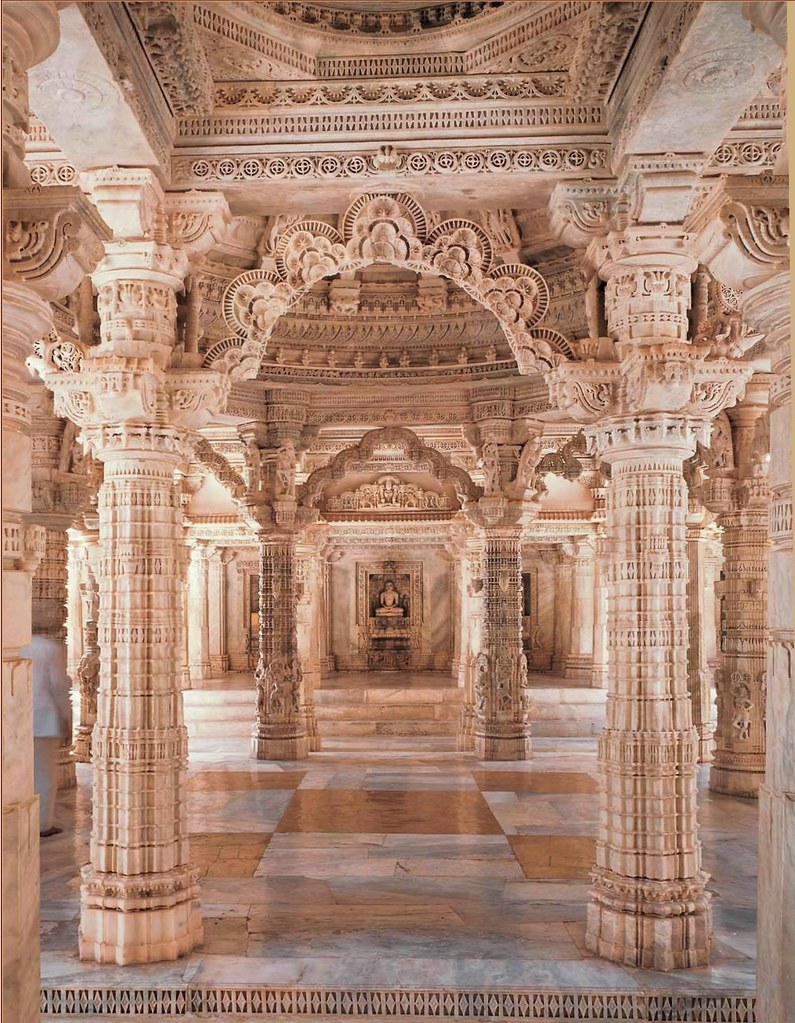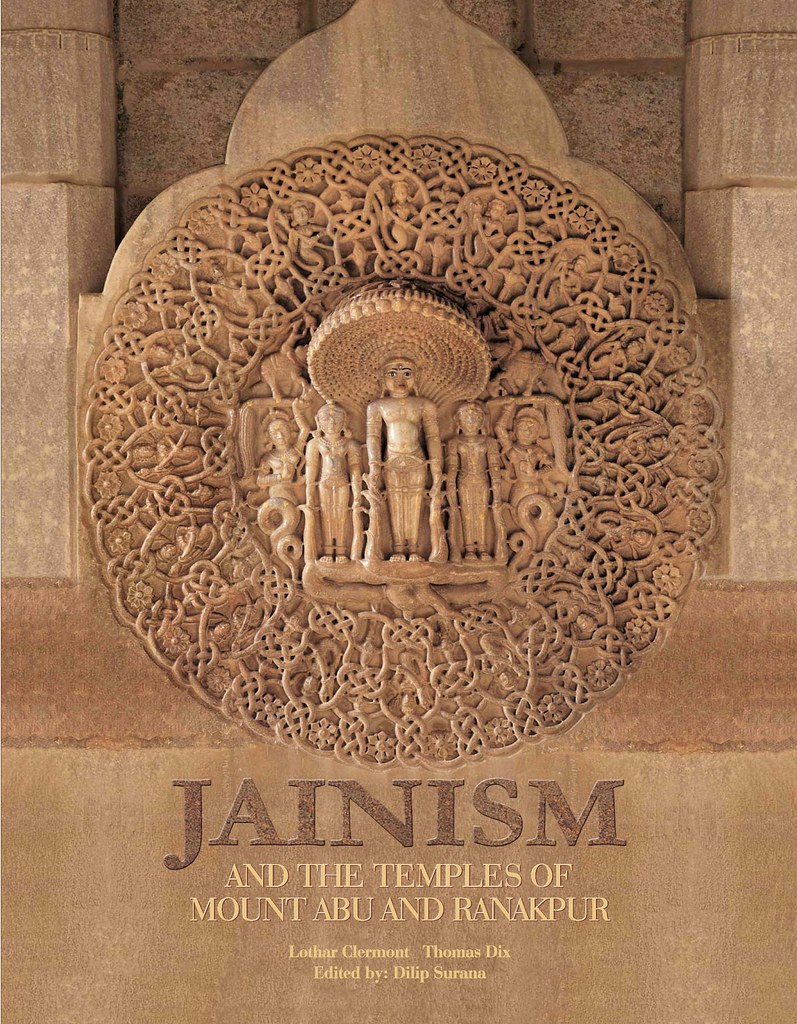We are happy being able to present the book
Jainism And The Temples Of Mount Abu And Ranakpur
by Dix, Clermont & Surana with the kind permission of the publisher and the authors in considerable parts.
Click the photos to enlarge, where possible.
Little is known about the Jain faith outside India, for the small Jain community has formed a gentle stream within the strong currents of the Indian mainstream. Though it shares many of its tenets with Hinduism, and is a contemporary of Buddhism, Jainism preaches an austere lifestyle, and has a philosophy all its own. However, Jain extravagance is unleashed when its temples where the architectural excellence and the sculptures are rendered as paeans of design reflecting a rich religious panorama. Since photography at these shrines is rarely permitted, especially in the areas in and around the sanctum, this book with its wonderful pictures of Mt. Abu and Ranakpur should go a long way in enlightening the visitor about the Jain way of life. The supporting text provides a concise insight about the various strands that go into the making of Jain religious beliefs.

About The Authors
Text:
Lothar Clermont, a native German, was born in 1954. From 1974 to 1985 he studied Archaeology, Art History and Oriental Languages in Bochum, Florence and Rome and joined several excavations in between. Since 20 years he is guiding groups in India, China and the Islamic World. Some articles on art and architecture in Oriental World were published in this time. Together with Thomas Dix he did a splendid coffee-table book on Rajasthan; a second revised edition is in the press.
 www.dix-fotodesign.deThomas Dix was born in Füssen/Germany in 1959. After having finished his studies of photo-design he is living and working since 1988 in Grenzach-Wyhlen close to Basle/Switzerland as a free-lance photographer specializing in architecture and interior. His work is continuously published in magazines, reviews, calendars and books and also can be seen under www.dix-fotodesign.de. His passion became the Indian Subcontinent, whose beauty and variety he has been photographing on seven long journeys in the years 1991 to 2001. His photographs of India have been printed in guide-books, calendars, magazines and coffee-table books; among those are two architectural monographies on Fatehpur Sikri and on Ranakpur. Also two coffee-table books on Rajasthan have been published: one edited by Rajasthan Tourism, where he contributed the major part of photographs, the other one he did together with Lothar Clermont - a second revised edition of this splendid work is in the press.
www.dix-fotodesign.deThomas Dix was born in Füssen/Germany in 1959. After having finished his studies of photo-design he is living and working since 1988 in Grenzach-Wyhlen close to Basle/Switzerland as a free-lance photographer specializing in architecture and interior. His work is continuously published in magazines, reviews, calendars and books and also can be seen under www.dix-fotodesign.de. His passion became the Indian Subcontinent, whose beauty and variety he has been photographing on seven long journeys in the years 1991 to 2001. His photographs of India have been printed in guide-books, calendars, magazines and coffee-table books; among those are two architectural monographies on Fatehpur Sikri and on Ranakpur. Also two coffee-table books on Rajasthan have been published: one edited by Rajasthan Tourism, where he contributed the major part of photographs, the other one he did together with Lothar Clermont - a second revised edition of this splendid work is in the press.
FOREWORD
Every year, thousands of visitors throng the Jain temples of Mt. Abu and Ranakpur. Two reactions are common to all of them: on the one hand they are totally astonished and almost overawed by these marvels of artistic precision and, on the other, irritated and confounded by the ban on photography in Abu. This volume attempts to fulfil this very understandable desire to capture the beauty of these monuments on film and ‘take it back home’. Thomas Dix’s photos are captivating. The employees at the Ranakpur Temple assured the photographer, one of the most knowledgeable experts on Indian architecture, that his photographs ‘had indeed recreated the temples afresh’.
All over Rajasthan, visitors are exposed to a variety of Jain temples, whether it is in Jaisalmer, Osian, Mt. Abu and Ranakpur. However, in comparison to the number of sites visited, precious little information is available on them. The reason for this is that, partly, most traditional Rajasthan guidebooks devote very little space to Jainism and, partly, that of all the Indian religions; this is the least accessible to the Western mind. During preparation of his journey, the visitor reads a lot about Hinduism, perhaps also about Buddhism but the religious conception of the Jain’s remains frequently quite vague for him. It is mostly the visual impression of artistic grandeur that sticks in the memory. This introductory text hopes to remedy this omission considerably. It hopes to acquaint the reader in a very simple manner with one of the most fascinating and oldest religion of India, to introduce him to the Jain community and to enable him to understand Jain art in its religious context.
By Indian standards, the Jain community is relatively small. It is probably seven million strong. Thus, the large number of Jain temples is, therefore, even more surprising since it is not in proportion to the number of its followers. This is but one of the many contradictions that pervade this religion: although Jainism, for example, preaches total abstinence and renunciation of the world, yet the Jains in traditional professions are rarely poor: while the Digambaras insist on the full nudity of their monks, yet their temples in contrast are strangely over laden.
Even after reading the book, the Western reader will in all likelihood still not be able to resolve these contradictions. He can then console himself with the Jain parable of the blind men and the elephant according to which an elephant depending on which part of its body one touch can be defined and describes. However, this book succeeds in its objective if, after having read it, one feels confident of asking a Jain intellectually profound questions on his religion.

